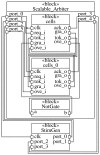Analyzing SystemC Designs: SystemC Analysis Approaches for Varying Applications
- PMID: 25946632
- PMCID: PMC4481889
- DOI: 10.3390/s150510399
Analyzing SystemC Designs: SystemC Analysis Approaches for Varying Applications
Abstract
The complexity of hardware designs is still increasing according to Moore's law. With embedded systems being more and more intertwined and working together not only with each other, but also with their environments as cyber physical systems (CPSs), more streamlined development workflows are employed to handle the increasing complexity during a system's design phase. SystemC is a C++ library for the design of hardware/software systems, enabling the designer to quickly prototype, e.g., a distributed CPS without having to decide about particular implementation details (such as whether to implement a feature in hardware or in software) early in the design process. Thereby, this approach reduces the initial implementation's complexity by offering an abstract layer with which to build a working prototype. However, as SystemC is based on C++, analyzing designs becomes a difficult task due to the complex language features that are available to the designer. Several fundamentally different approaches for analyzing SystemC designs have been suggested. This work illustrates several different SystemC analysis approaches, including their specific advantages and shortcomings, allowing designers to pick the right tools to assist them with a specific problem during the design of a system using SystemC.
Figures







References
-
- Grosse D., Drechsler R. Quality-Driven SystemC Design. Springer; New York, NY, USA: 2010.
-
- Marquet K., Moy M., Karkare B. A. Theoretical and Experimental Review of SystemC Front-Ends. Proceedings of the Forum on Specification and Design Languages (FDL); Southampton, UK. 14–16 September 2010; pp. 124–129.
-
- Fey G., Große D., Cassens T., Genz C., Warode T., Drechsler R. ParSyC: An Efficient SystemC Parser. Proceedings of the Workshop on Synthesis And System Integration of Mixed Information Technologies (SASIMI); Kanazawa, Japan. 18–19 October 2004; pp. 148–154.
-
- Parr T.J., Dietz H.G., Cohen W. Purdue Compiler-Construction Tool Set. Purdue University, School of Electrical Engineering; West Lafayette, IN, USA: 1990.
-
- Parr T.J., Quong R.W. ANTLR: A predicated-LL (k) parser generator. Softw. Pract. Exp. 1995;25:789–810.
LinkOut - more resources
Full Text Sources
Other Literature Sources

